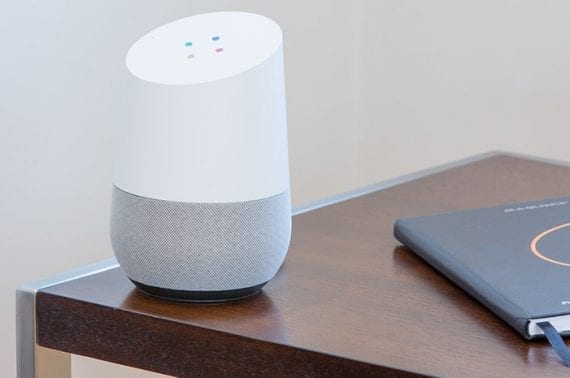
Smart speakers, smartphones, and smart devices on the internet of things should lead to a lot more voice search in 2019 and beyond. Photo: Thomas Kolnowski.
The way you market your ecommerce business today may not work tomorrow. This is true for all marketing and all time. Companies should watch important marketing trends — adapting and experimenting to discover what forms provide the best return.
In 2019, you’ll likely hear about artificial intelligence, influencer marketing, virtual reality, and any number of other marketing and advertising possibilities. But some may be a few years from having an impact.
So what about something a bit more practical? Here are five ecommerce marketing trends your business should consider in the coming year. None of these are new, but they should be effective.
1. Site Performance
Marketers have long been involved in website design and development. Think about it. The marketing department often controls site content, manages search engine optimization, and defines layout and navigation.
Sure, it will be a technical person, a code writer, who does a lot of the work. But marketing drives the decisions in many businesses.
In 2019, expect site performance monitoring to also become an important marketing task as an extension of SEO and user experience.
“According to Google, the average time it takes for a mobile landing page to load is now 22 seconds,” wrote Edwin Toonen in an April 2017 article for Yoast. “Compare that with the three seconds visitors need to decide if they want to stay for your page to load. People are impatient. They want something, and they want it now. While page speed is important for your SEO, it is even more important for your UX, conversion, and general customer happiness.”
Google has made page speed a ranking factor. Good ecommerce websites will be fast-loading progressive web apps and accelerated mobile pages.
“We’re working towards greatly improving all aspects of the user journey. The first step was reducing page load speeds across the site by optimizing image file sizing, types, and resolution. This improved conversion rate, mobile organic rankings, and customer happiness,” said Alan LaFrance, marketing strategy manager for LawnStarter, a nationwide, ecommerce-powered service company.
2. Voice Search
Back in September 2014, Andrew Ng, CEO of Baidu, the largest search engine in China, predicted that “in five years time at least 50 percent of all searches are going to be either through images or speech.”
Ng’s comments came in a Fast Company article, “Inside Baidu’s Plan To Beat Google By Taking Search Out Of The Text Era.” At that time, his company saw about 10 percent of all queries come in via voice search.
Fast forward to 2018 and “voice technology is poised to permeate all aspects of our lives — at home, at work, and on the go,” explained Susan Engleson, senior director of emerging products for comScore in a 2017 presentation. Engleson had three key takeaways, explaining how smartphones, the internet of things, and smart speakers are driving voice search.
So let’s connect the dots. If a greater percentage of search queries are voice rather than text, marketers need to optimize not just for text, but also for voice, too.
Kent Lewis, the president and founder of marketing firm Anvil assemble a list of voice search best practices. It is not a bad place to start.
3. Content Marketing
“In the midst of the daily grind, it’s easy to forget that content marketing as we know it is still a relatively new phenomenon. As recently as a few years ago, marketers handled content mostly as a side project. It was more of a bonus than an essential role — something you did when you had time because it took a backseat to more traditional marketing projects and responsibilities,” wrote Forbes contributor, John Hall.
“That’s changed. Where marketing of the past used to push one-sided conversations toward consumers, successful brands know that content marketing opens the door for two-way conversations and relationships with audiences unlike anything before.”
Increasingly content marketing is helping ecommerce businesses better engage with customers, provide information, and ultimately sell products. Of late, content marketing and SEO have become very closely connected. For example, SEO broken-link building is emerging as a popular content marketing strategy.
In 2019, content marketing will continue to grow and become a more important part of ecommerce marketing. Content may not seem like a new marketing trend, but it is still on the rise, and in 2019 it may be time to double down.
4. Reddit Ads
“If you’re not on Reddit and you’re not trying to get traffic from it, you’re missing out,” said entrepreneur and marketing authority Neil Patel. To be fair Patel’s comments were about social media marketing and content marketing on Reddit rather than advertising on it.
But as freelance marketer Jeremy Sonne put it, “one of the biggest ecommerce opportunities I see in 2019 is Reddit ads.” Reddit ads are “super underutilized, and with the ability to target specific subreddits you can highly niche your offering and reach the perfect audience. In addition, the ads are incredibly cheap as compared to Facebook or Google in most cases.”
5. Mobile Advertising
Mobile is by no means new. Marketers have been working on mobile site optimization, responsive design, mobile apps, and similar for years.
Mobile advertising is not even new. However, in 2019 you should be investing a greater percentage of your pay-per-click marketing into mobile. The potential is massive.
By some estimates, there are more than 1.2 billion mobile users worldwide. And more than half of all PPC conversions reportedly come from mobile devices.